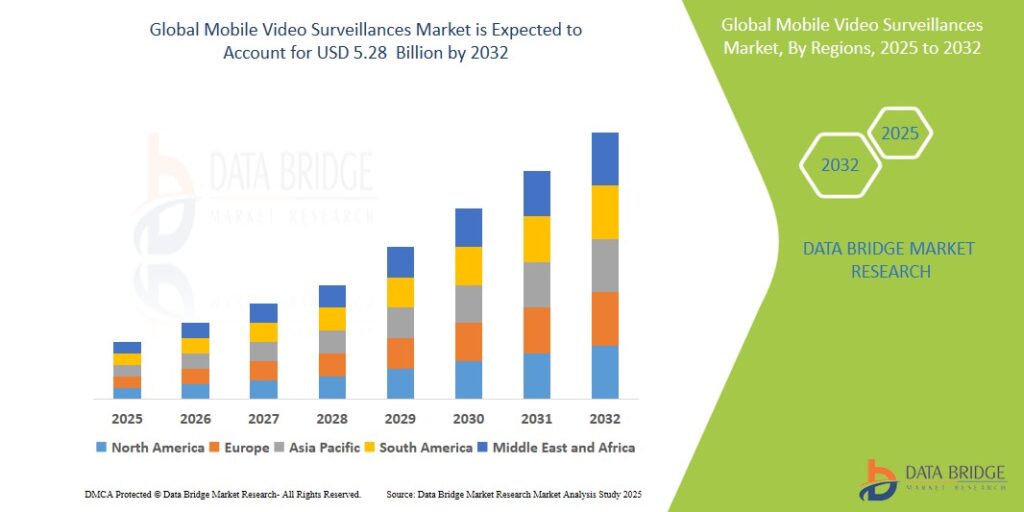Growth Trends in the Global Mobile Video Surveillance Market
Content:
The global mobile video surveillance market has emerged as a vital segment within the broader surveillance and security ecosystem. As urbanization intensifies and threats to public and private safety evolve, mobile video surveillance systems are playing an increasingly critical role in enhancing real-time monitoring, rapid response, and operational efficiency. These systems, mounted on vehicles or portable units, offer flexibility, mobility, and connectivity that traditional fixed surveillance systems cannot match.
From public transportation to law enforcement and commercial fleet operations, mobile surveillance technologies are rapidly gaining traction across various sectors. Their integration with technologies like artificial intelligence (AI), edge computing, and 5G connectivity further enhances their value proposition, making them indispensable tools in modern security infrastructure.
Market Overview
The mobile video surveillance market includes cameras, recording systems, storage units, and related software, all installed on mobile assets such as police cars, buses, trains, emergency response vehicles, and drones. Unlike stationary surveillance systems, mobile video surveillance allows for broader area coverage, adaptability, and deployment in dynamic or remote environments.
In recent years, the market has witnessed steady growth due to increasing concerns over security, theft, vandalism, terrorism, and public safety. Moreover, technological advances have made mobile systems more compact, affordable, and feature-rich, further accelerating their adoption across sectors such as transportation, defense, construction, and event security.
Key Market Drivers
1. Rising Security Concerns
The growing incidence of criminal activity, terrorism, and civil unrest in both developed and developing nations has pushed public agencies and private businesses to invest in mobile surveillance solutions. Law enforcement agencies rely heavily on vehicle-based surveillance for crime detection and evidence collection in real time.
2. Growth of Smart Cities and IoT Integration
Smart city initiatives around the world are integrating mobile video surveillance as part of their broader infrastructure. These systems, when integrated with Internet of Things (IoT) devices, enable data sharing across platforms, offering law enforcement and municipal authorities better situational awareness and operational efficiency.
3. Increasing Use in Transportation and Fleet Management
Mobile video surveillance systems are essential in public transport (buses, trains) for passenger safety and incident management. Similarly, logistics and fleet management companies use them to monitor driver behavior, prevent cargo theft, and ensure compliance with traffic laws.
4. Advancements in Technology
The integration of AI, machine learning, high-resolution imaging (e.g., 4K), and real-time video analytics has transformed mobile surveillance. Features such as facial recognition, license plate recognition (LPR), and motion detection allow for faster identification of threats and anomalies. Cloud-based storage and 5G connectivity further ensure instant access to video feeds and data analytics from anywhere.
Market Segmentation
The mobile video surveillance market can be segmented based on product type, application, and geography:
-
By Product Type:
-
DVRs and NVRs (Digital/Network Video Recorders)
-
IP Cameras
-
Analog Cameras
-
Monitors and Storage Devices
-
-
By Application:
-
Law Enforcement
-
Public Transportation
-
Emergency Services
-
Industrial and Construction Sites
-
Commercial Fleets and Delivery Services
-
-
By Geography:
-
North America
-
Europe
-
Asia-Pacific
-
Latin America
-
Middle East and Africa
-
North America currently dominates the market, largely due to robust infrastructure, high public safety expenditure, and early adoption of advanced surveillance technologies. However, Asia-Pacific is expected to witness the fastest growth, driven by rapid urbanization, growing population, and increasing investment in public infrastructure and smart city projects.
Competitive Landscape
The market is moderately competitive with the presence of several key players offering a range of mobile surveillance solutions. These companies are focusing on product innovation, partnerships, and regional expansions to strengthen their market position.
Major Players Include:
-
Hikvision Digital Technology Co., Ltd.
-
Dahua Technology Co., Ltd.
-
FLIR Systems (now part of Teledyne)
-
Axis Communications
-
Bosch Security Systems
-
Pelco (Motorola Solutions)
-
Eagle Eye Networks
-
Pro-Vision Video Systems
These players are continually investing in R&D to enhance product features such as AI integration, edge computing, and improved connectivity. Many are also focusing on cloud-based solutions that support centralized monitoring across large geographic areas.
Challenges
Despite its growth, the mobile video surveillance market faces certain challenges:
-
High Initial Costs: Advanced mobile surveillance systems can be expensive to deploy, especially for small or medium-sized fleets.
-
Data Privacy Concerns: The use of facial recognition and constant video monitoring raises legal and ethical questions about surveillance and data use.
-
Connectivity and Bandwidth Issues: In rural or underdeveloped areas, reliable network coverage may be lacking, limiting real-time data transmission and remote monitoring.
-
Cybersecurity Risks: As mobile systems become more connected, they are also more vulnerable to hacking, data breaches, and software manipulation.
Future Outlook
The mobile video surveillance market is projected to grow significantly over the next five to seven years. Market analysts anticipate a compound annual growth rate (CAGR) of around 8–12%, depending on region and sector. Several trends are expected to shape the future of the market:
-
Increased Adoption of AI and Edge Analytics: Cameras with built-in analytics capabilities will reduce the reliance on centralized processing, allowing for faster threat detection and response.
-
Rise of Drone Surveillance: Drones equipped with video surveillance systems are becoming vital tools for crowd monitoring, traffic management, and disaster response.
-
Cloud-Based Solutions: Cloud computing will allow easier scalability, centralized access to video feeds, and cost-effective data storage.
-
Expansion into Emerging Markets: As governments and private sectors in Africa, Latin America, and Southeast Asia invest in public safety, demand for mobile surveillance systems is expected to increase.
Conclusion
The global mobile video surveillance market is rapidly expanding, offering a dynamic and flexible alternative to traditional stationary systems. From enhancing public safety to optimizing fleet operations, mobile surveillance technologies are revolutionizing the way we monitor and respond to security threats. Continued technological innovation, supported by increasing global security needs and urban development, will ensure that mobile video surveillance remains a key pillar of the global security ecosystem in the years ahead.
Get more Details
https://www.databridgemarketresearch.com/reports/global-mobile-video-surveillances-market






